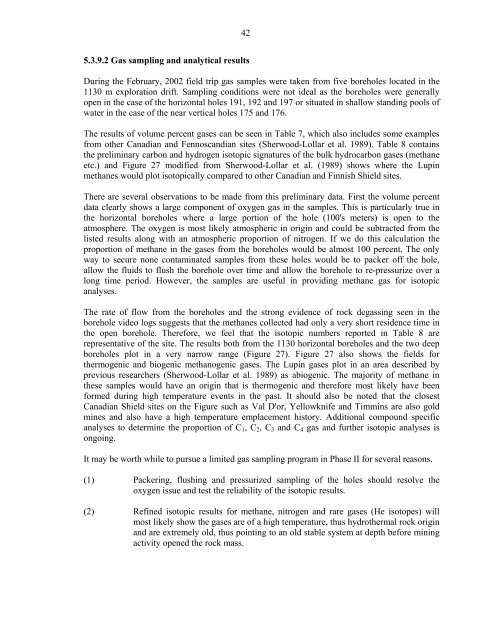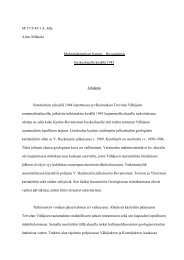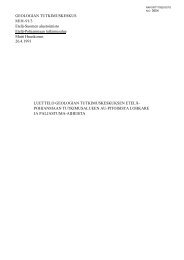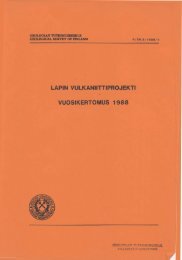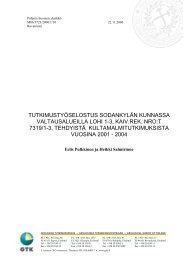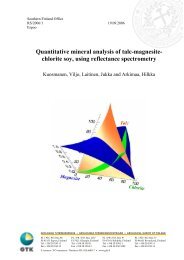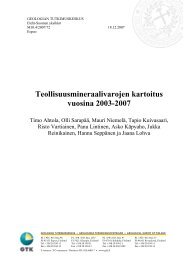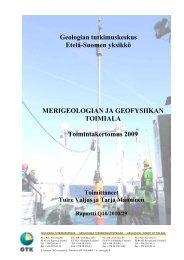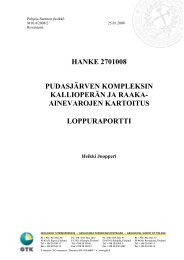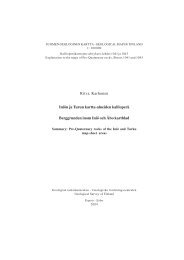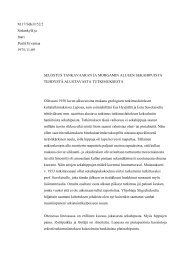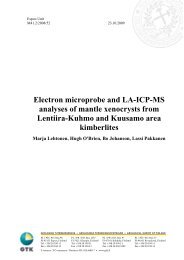REPORT OF PHASE
REPORT OF PHASE
REPORT OF PHASE
- No tags were found...
Create successful ePaper yourself
Turn your PDF publications into a flip-book with our unique Google optimized e-Paper software.
425.3.9.2 Gas sampling and analytical resultsDuring the February, 2002 field trip gas samples were taken from five boreholes located in the1130 m exploration drift. Sampling conditions were not ideal as the boreholes were generallyopen in the case of the horizontal holes 191, 192 and 197 or situated in shallow standing pools ofwater in the case of the near vertical holes 175 and 176.The results of volume percent gases can be seen in Table 7, which also includes some examplesfrom other Canadian and Fennoscandian sites (Sherwood-Lollar et al. 1989). Table 8 containsthe preliminary carbon and hydrogen isotopic signatures of the bulk hydrocarbon gases (methaneetc.) and Figure 27 modified from Sherwood-Lollar et al. (1989) shows where the Lupinmethanes would plot isotopically compared to other Canadian and Finnish Shield sites.There are several observations to be made from this preliminary data. First the volume percentdata clearly shows a large component of oxygen gas in the samples. This is particularly true inthe horizontal boreholes where a large portion of the hole (100's meters) is open to theatmosphere. The oxygen is most likely atmospheric in origin and could be subtracted from thelisted results along with an atmospheric proportion of nitrogen. If we do this calculation theproportion of methane in the gases from the boreholes would be almost 100 percent. The onlyway to secure none contaminated samples from these holes would be to packer off the hole,allow the fluids to flush the borehole over time and allow the borehole to re-pressurize over along time period. However, the samples are useful in providing methane gas for isotopicanalyses.The rate of flow from the boreholes and the strong evidence of rock degassing seen in theborehole video logs suggests that the methanes collected had only a very short residence time inthe open borehole. Therefore, we feel that the isotopic numbers reported in Table 8 arerepresentative of the site. The results both from the 1130 horizontal boreholes and the two deepboreholes plot in a very narrow range (Figure 27). Figure 27 also shows the fields forthermogenic and biogenic methanogenic gases. The Lupin gases plot in an area described byprevious researchers (Sherwood-Lollar et al. 1989) as abiogenic. The majority of methane inthese samples would have an origin that is thermogenic and therefore most likely have beenformed during high temperature events in the past. It should also be noted that the closestCanadian Shield sites on the Figure such as Val D'or, Yellowknife and Timmins are also goldmines and also have a high temperature emplacement history. Additional compound specificanalyses to determine the proportion of C 1 , C 2 , C 3 and C 4 gas and further isotopic analyses isongoing.It may be worth while to pursue a limited gas sampling program in Phase II for several reasons.(1) Packering, flushing and pressurized sampling of the holes should resolve theoxygen issue and test the reliability of the isotopic results.(2) Refined isotopic results for methane, nitrogen and rare gases (He isotopes) willmost likely show the gases are of a high temperature, thus hydrothermal rock originand are extremely old, thus pointing to an old stable system at depth before miningactivity opened the rock mass.


